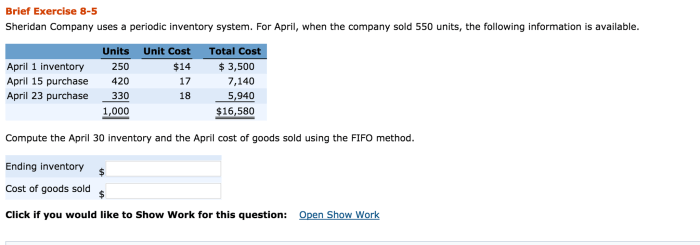Sheridan company uses a periodic inventory system – Sheridan Company’s adoption of a periodic inventory system has revolutionized its inventory management practices, bringing forth a multitude of advantages and streamlining operations. This comprehensive guide delves into the intricacies of this system, exploring its benefits, challenges, and impact on financial reporting, providing valuable insights for organizations seeking to optimize their inventory management strategies.
Inventory Management at Sheridan Company: Sheridan Company Uses A Periodic Inventory System

Sheridan Company employs a periodic inventory system to manage its inventory, which offers advantages such as simplicity, cost-effectiveness, and alignment with their business model.
Implementing a periodic inventory system at Sheridan Company involves several key steps, including establishing a physical inventory cutoff date, counting and recording on-hand inventory, and calculating inventory value using an appropriate cost flow assumption.
Benefits and Challenges of a Periodic Inventory System
Sheridan Company benefits from using a periodic inventory system, as it provides accurate inventory records, reduces the risk of inventory shrinkage, and simplifies inventory management processes.
Potential challenges include the need for periodic inventory counts, which can be time-consuming and disruptive, and the potential for inventory inaccuracies due to human error.
Impact on Financial Reporting, Sheridan company uses a periodic inventory system
A periodic inventory system affects Sheridan Company’s financial reporting practices by providing the basis for inventory valuation and cost of goods sold calculations.
Inventory valuation methods, such as FIFO or LIFO, impact the reported value of inventory on the balance sheet, while the cost of goods sold calculation determines the expense recognized on the income statement.
Comparison with Other Inventory Systems
| Feature | Periodic Inventory System | Perpetual Inventory System |
|---|---|---|
| Inventory Counting | Periodic | Continuous |
| Cost Flow Assumption | Assumed at period end | Recorded as transactions occur |
| Suitability | Small businesses, low inventory turnover | Large businesses, high inventory turnover |
Inventory Management Best Practices
Best practices for managing inventory effectively within a periodic inventory system include:
- Establishing clear inventory policies and procedures.
- Conducting regular inventory counts to ensure accuracy.
- Using technology to automate inventory management processes.
- Implementing inventory optimization techniques to minimize holding costs.
Clarifying Questions
What are the advantages of using a periodic inventory system?
A periodic inventory system offers numerous advantages, including simplified record-keeping, reduced labor costs, and the ability to conduct physical inventory counts at convenient intervals.
How does a periodic inventory system impact financial reporting?
A periodic inventory system affects financial reporting by determining the inventory value and cost of goods sold at specific intervals, which are then reflected in the company’s financial statements.
What are some best practices for managing inventory effectively within a periodic inventory system?
Best practices for effective inventory management in a periodic inventory system include regular physical inventory counts, accurate record-keeping, and the use of inventory management software to automate processes and minimize errors.


